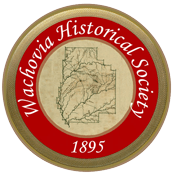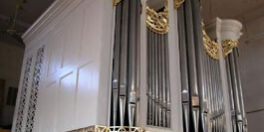By the end of the eighteenth century there were three pipe organs in Wachovia built by David Tannenberg, an astonishing number in the new nation. In the summer of 1998, the great organ built in 1800 for Home Moravian Church and dismantled in 1913, was exhibited at the Gallery at MESDA (Museum of Early Southern Decorative Arts) so that the public could watch the Staunton, Virginia, organ builders, Taylor and Boody, reassemble an historically important musical jigsaw puzzle. The parts of this organ, one of the three built by Tannenberg between the early 1760s and 1800 for the Wachovia settlement, had been stored in the attic of the old Boys School. The Wachovia Historical Society pledged $12,000 to be paid over five years in support of this restoration.
More recently the Society has contributed $4000 for the preservation and conservation of an organ made by Tannenberg in 1798 for the Salem community. This instrument was first played for a song service (Singstunde) on May 22, 1798. It was used in two Salem chapels until it was stored in 1864 to be restored 100 years later by McManis Organ Company for the Single Brothers Saal.
Tannenberg, born at Berthelsdorf, in Saxony near Herrnhut, 1728, was educated in Moravian schools before emigrating to the Bethlehem colony in 1749 to work as a joiner. Shortly thereafter he married Anna Rosina Kern. In 1757 he became assistant to Johann Gottlob Klemm, a Moravian organ builder trained at Dresden, and with him built and repaired instruments for Pennsylvania churches.
In the early 1760s they constructed an organ for the Bethabara congregation, the first of the Wachovia trio. This small one-rank organ, set up by Brother Johann Michael Graff, was played for the first time on July 8, 1762. It remained in use in Bethabara until 1798 when it was moved to Single Brothers’ House. It was used at Friedberg Moravian Church from 1824 until about 1900.
Tannenberg and his family moved to Lititz in 1765 where he is known to have produced 41 instruments before his death in 1804 in nearby York where he had gone to install an organ. He had many assistants, one of whom, Joseph Ferdinand Bulitschek, moved to Wachovia where he built an organ for the Salem Gemeinhaus and another (destroyed in a 1942 fire) for Bethania Chapel. When Tannenberg had difficulty in hiring assistants, he requested help from Herrnhut. In 1793, Johann Philip Bachmann, a trained instrument maker arrived and soon married David and Anna Rosina’s youngest daughter, Anna Maria. Father and son-in-law made most of their organ parts in a stone shop in Lititz but final assembly could be done only on site.
Tannenberg always considered three factors in design: size, durability, and use with other instruments. In the case of Salem organs he suggested different stops (grouping of pipes) to make repairs easier. His 1798 organ had one manual and five stops. Its console, the organ desk that contains keyboards and other controls, was reversed. There were 150 metal pipes and 108 wooden pipes. While most of the Lititz-built organs were white, this one was painted to resemble mahogany.
After he finished his last instrument for Salem, Tannenberg was too frail to make the trip for installation in Home Church and in his stead sent Bachmann who remained for a year to oversee the project. Such a large organ was usually located in a gallery with bellows placed in the attic. When there was debate in the congregation about its proper place, the matter was submitted to the lot that directed placement in the gallery on the steeple side. For the Lovefeast after the consecration service on November 9, 1800, one thousand buns were baked but so many people attended that buns had to be cut in half to serve the two thousand present.
This organ was modified in 1870 and restored in 1910 by S.E. Peterson only to be dismantled three years later during a church renovation. Taylor and Boody found most of the original pipes (there were 644 in all) and fragments of others from the 1798 assembly. The organ returned to Salem in early 2004 and was placed in the James Gray Auditorium of the new Old Salem Visitor Center. A dedication recital was held by Old Salem, Inc. on March 18, 2004; and the Home Moravian Church held a rededication service, using a modern translation of the original 1800 order of service, on March 21.





